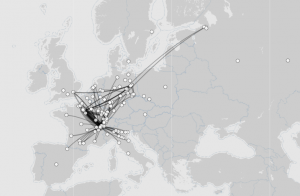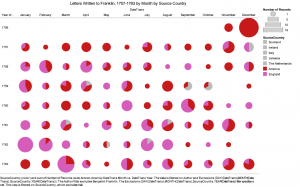“Mapping the Republic of Letters” is an exciting DH project created by a group of students and professors at Stanford. At the basis of the project is The Republic of Letters– a community of Enlightenment-era scholars including Voltaire, Galileo, Ben Franklin, and John Locke, that exchanged ideas across national borders. The aim of the DH project is to provide insight into way members of that community interacted, by analyzing and illustrating their communication trends. We can better understand how the DH project works, by employing Miriam Posner’s process of breaking the project down into sources, processes, and presentations.
Sources
The project analyzed correspondence data for several different figures. The source data for each figure varied, but generally was some kind of database of letters they exchanged. For Voltaire, this database was provided by the the Electronic Enlightenment Project at Oxford University. For Franklin, that database was found online at FranklinPapers.org.
Processes
The processing of this data generally took the form of cataloging available information about the letters a particular person exchanged into a spreadsheet. For example, the Franklin group extracted information such about each letter including “its date, its author and recipient and their genders, communities (aka “professions” in an eighteenth-century sense of the word), and places of birth; its source location and the location of its recipient.”
Some groups separated these records into two spreadsheets, one containing information about the letters themselves, and one containing information about the individuals on the other end of an exchange. It seems further research was sometimes required to fill out this second spreadsheet. For example, the Voltaire group wanted to know of Voltaire’s correspondents “What were their occupations? What was their milieu?”
Part of processing also included choosing a date range within which to analyze.
Presentation
The information was eventually presented in a variety of ways, in an attempt to answer different questions. Information was generally presented in maps or graphs.
For example, the Voltaire group created this interactive map to allow people to visualize and explore where letters where being sent and received:
Graphs were another common way to present information. For example, the Franklin group created this series of pie-charts to illustrate the origin country of the various letters Franklin received with a date range.


Here is an interesting I found about this digital humanities project!
Wrong html tag. Article
This is fascinating . I’m very excited to explore this – who would’ve thought that Benjamin Franklin and Voltaine had any relation to each other? I love the amount of quantitative analysis done on seemingly qualitative relationships.
This is such a cool project! I’ve always found Ben Franklin to have some pretty funny letters (seriously, look him up, they’re pretty vulgar), so it’s interesting to see the letters he wrote in an intellectual capacity. I wish I knew more about how the letters themselves were processed , since it’s hard to tell if they were digitized manually, or just analyzed by hand into the spreadsheet with relevant data. It’d be cool to see a digital copy of the letters themselves along with the data.
I thought this post was really well organized! The use of headings and paragraphs to break up lumps of text
is something I definitely need to work onworks really well for you. Good stuff!I really enjoyed reading your post. I specially appreciated how you broke down the information into different headings -sources, processes and presentation- because it gives the reader a clearer understanding of your analysis. The DH project in itself is so fascinating, and it’s interesting to see the connections and interactions between Enlightenment era scholars.
This project is amazing. It visualizes how idea traveled and affected the world in the past.